After being tracked by Liverpool this summer, Jérémy Doku decided to make the smarter move for his immediate career to Stade Rennais. It is believed that Jürgen Klopp still sees the 18-year-old Belgian as Sadio Mané’s successor in Merseyside. Right now, Doku will likely be brought in to replace Raphinha, who left for Marcelo Bielsa’s Leeds United, and will leave big boots to fill.
Moving from R.S.C. Anderlecht, his strong start to the domestic campaign left many to believe that the 5’6” forward had already outgrown the Jupiler Pro League at such a young age. At the start of this term, Doku has been utilised as a left-winger, but he has plenty of experience as a right-winger in the first-team from last season. We will distinguish what he does on both wings through an analysis of his performances.
Doku’s main strength is his dynamism in the final third with his direct style by running straight at defenders with pace while being able to cross accurately at top speed. He has excellent balance, coordination, and changes of pace which leads to him getting fouled often. This scout report will display how he plays on the left and right, and how he will fit into Julien Stéphan’s tactics.
In this tactical analysis, we will cover his main attributes, his role in and out of possession, and how well this would translate to Stéphan’s style of play.
Jérémy Doku Style of play
When analysing Doku’s tactical profile, we will cover three main attributes of his game. These join up to offer an insight into the kind of player that Doku is and what he could grow to become in the future. He is only 18 years old and has made five appearances for the Belgian senior squad, he is already a very good player, and now we will distinguish how good he could become, and more importantly, how he plans on doing so.
Now, what are Doku’s key strengths and what is his playing style? He is a bold player on the ball, almost always looking to be direct and take on his man with his excellent dribbling ability. He always aims to find the vertical option in the build-up, capable of carrying the ball, and the team, up the pitch into finishing positions. He often employs feints and tricks to beat his opponents, which is largely effective, but this can leave him caught out on occasion. The teenager is at his best on the counter-attack, as he is extremely dangerous on the break with his pace and acceleration.
Doku is a right-footed winger who is a creative player with great technique on the ball and good short-mid through passing ability. He largely occupies the wide spaces on either side of the pitch, preferring not to occupy the half-spaces when in possession, but rather he stays wide and stretches the opposition defence. From here, he can send in deliveries with either foot, opting for a couple of options: a low-driven cut-back near the byline at pace or a fizzed ball forwards into the path of a fellow attacker, but his attempted crosses tend to not leave the ground.

Doku’s heatmaps from the 2019/20 (left) & 2020/21 (right) seasons.
Jérémy Doku’s role in Julian Stéphan’s Tactics
Replacing Raphinha at Rennes will be a surmountable task, his importance to the French side should not be understated. The 24-year-old had an xGChain value of 10.97, the highest within the Rennes squad in the 2019/20 Ligue 1 season. xGChain being the total xG of every possession the player is involved in. This is just one indication of Raphinha’s importance in a creative sense to his side.
Raphinha, as a left-footed winger, would drift centrally from the right-wing more regularly than Doku was asked to at Anderlecht. Although the Brazilian spent the majority of his time out in the wide areas, these times where he would occupy the #10 space, would provide Rennes with a bit more unpredictability in their attacking approach. From here, he was afforded creative licence, with Benjamin Bourigeaud and Eduardo Camavinga also assisting in this regard slightly.
This season, Raphinha operated higher up the pitch due to a formation change from 4-4-2 to 4-3-3, which allowed him to position himself in the final third more often. This allowed him to use his impressive balance and agility, and attempt to take the ball past the opposition man in wide areas. Doku would excel in this regard, with his excellent low centre of gravity, body feints, and great technique enabling the young Belgian to breeze past slower full-backs with legitimate ease.

Raphinha’s heatmaps from the 2019/20 (left) & 2020/21 (right) seasons.
Stéphan would instruct Raphinha to drop deeper to collect the ball and attempt to complete wing rotations with Adrien Hunou or M’Baye Niang as the centre-forwards, and Hamari Traoré as the overlapping full-back. In these scenarios, he was often the facilitator in progressing the ball into the final third, rather than the player to whip in the final cross into the penalty area.
The French coach could alter these tactics somewhat with Doku’s arrival. The youngster’s blistering pace means that either balls down the line or diagonals from the opposite side of the pitch would be possible, and potentially a dangerous attacking avenue exploit. Especially as a right-winger, Doku could find space in behind and produce one of his cutbacks from the byline into the box for a goalscoring opportunity.
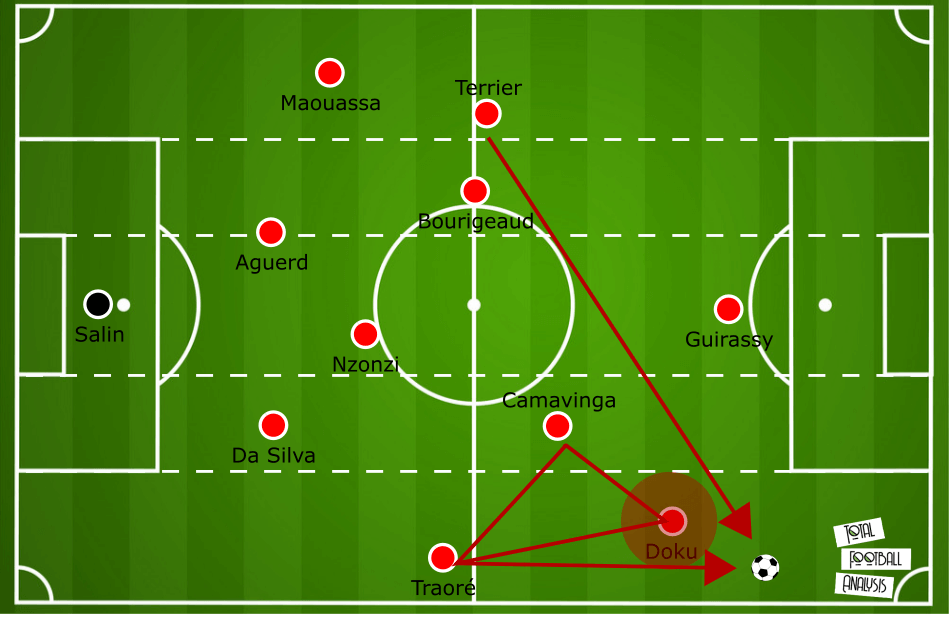
In the graphic above we can see the options that Doku has in the final third. Martin Terrier and Traoré can provide the balls in behind for the nimble forward to latch onto. He also has short passing options in the form of the right-back and Camavinga who has been played further forward this season, operating in the right half-space to link up with the right-winger.
Of course, Doku could well end up playing on the left-wing, and we will discuss how he would be a great option on this flank in this tactical analysis, but considering he was brought in after the departure of Raphinha, and from the appearances, he has made for Rennes so far, it is wise to judge that he will be utilised as a right-sided forward.
Ball progression via dribbling
Doku’s prized asset is his dribbling ability. In wide areas, the nimble forward has been very useful for his team, as he drags defenders out of position and then dribbled past them to create chances for his teammates. He is not just dribbling into cul-de-sacs and retaining possession either, he is an ambitious dribbler, jovial in carrying the ball into dangerous positions to carve out an opportunity to cross.
At the start of the 2020/21 season, Doku was dropping deeper than ever before to collect the ball and run at the opposition defence to spark attacking transitions. He would often take it past the wide midfielder before looking to use tricks and flicks to glide past the full-back at pace. This saw an increase in his progressive runs go from 3.71 last season to 4.63 so far this season. It is clear to see there is far more purpose to Doku’s efforts this term, and this has been reflected in his statistics.
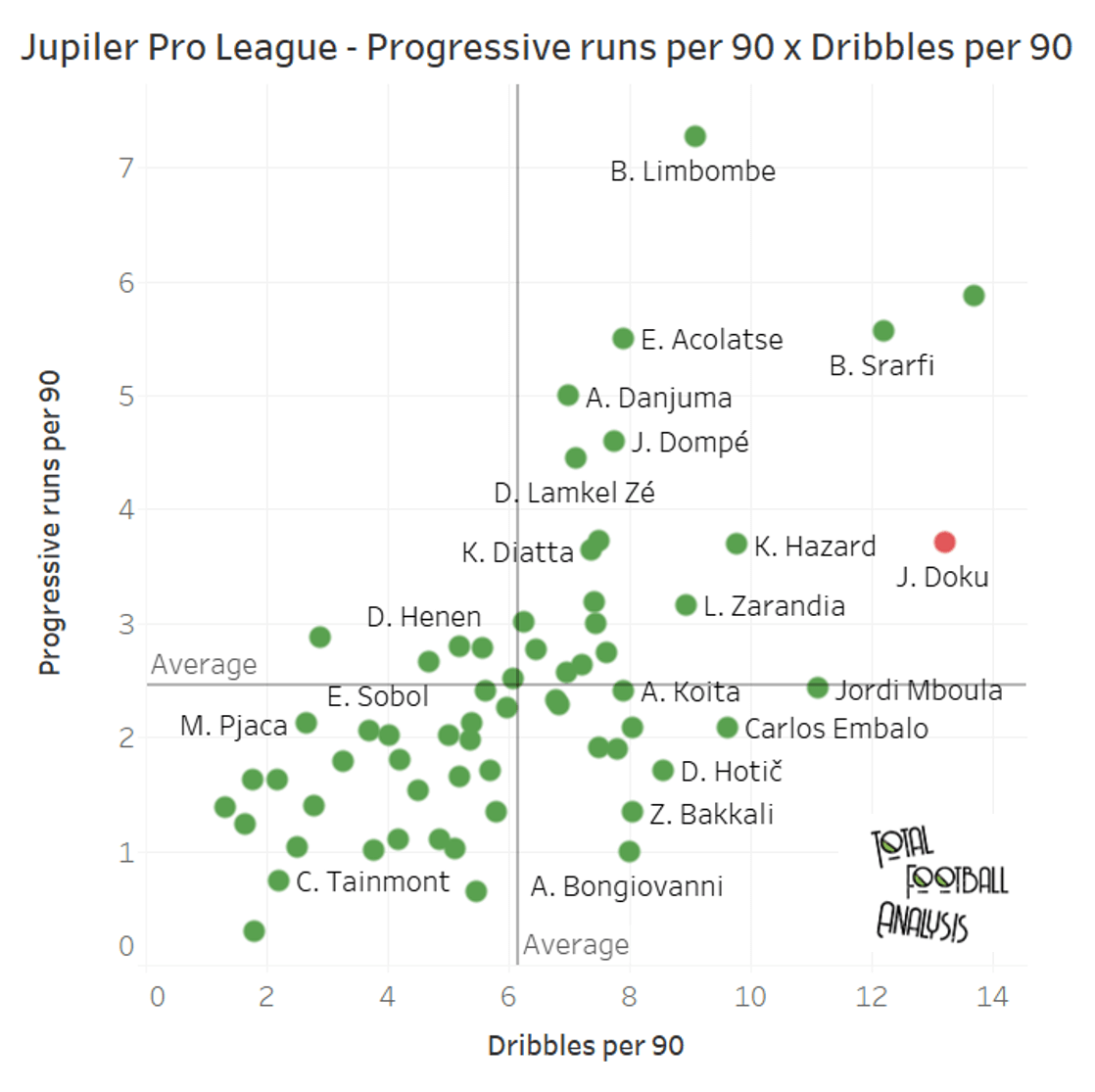
Scatter plot of Jupiler Pro League wingers’ dribbles per 90 compared with progressive runs per 90 from the 2019/20 campaign.
With 13.22 dribbles per 90 (at a 60.2% success rate) and 3.71 progressive runs per 90 last season, Doku was one of most proficient dribblers in the Belgian league over the last year. However, the quality of Belgian league full-backs will be lower than the full-backs in Ligue 1, and this should be taken into consideration.
When building-up their attacks, Rennes often relied upon Raphinha’s dribbling ability in 1v1 situations versus opposition defenders to progress the ball up the pitch and instigate attacking transitions. His agility and ability to quickly change direction like this while still moving at speed help him to perform this role effectively. This would assist the Brazilian in progressing the ball into the final-third from deeper positions, and from here would be asked to create something in an advanced zone.
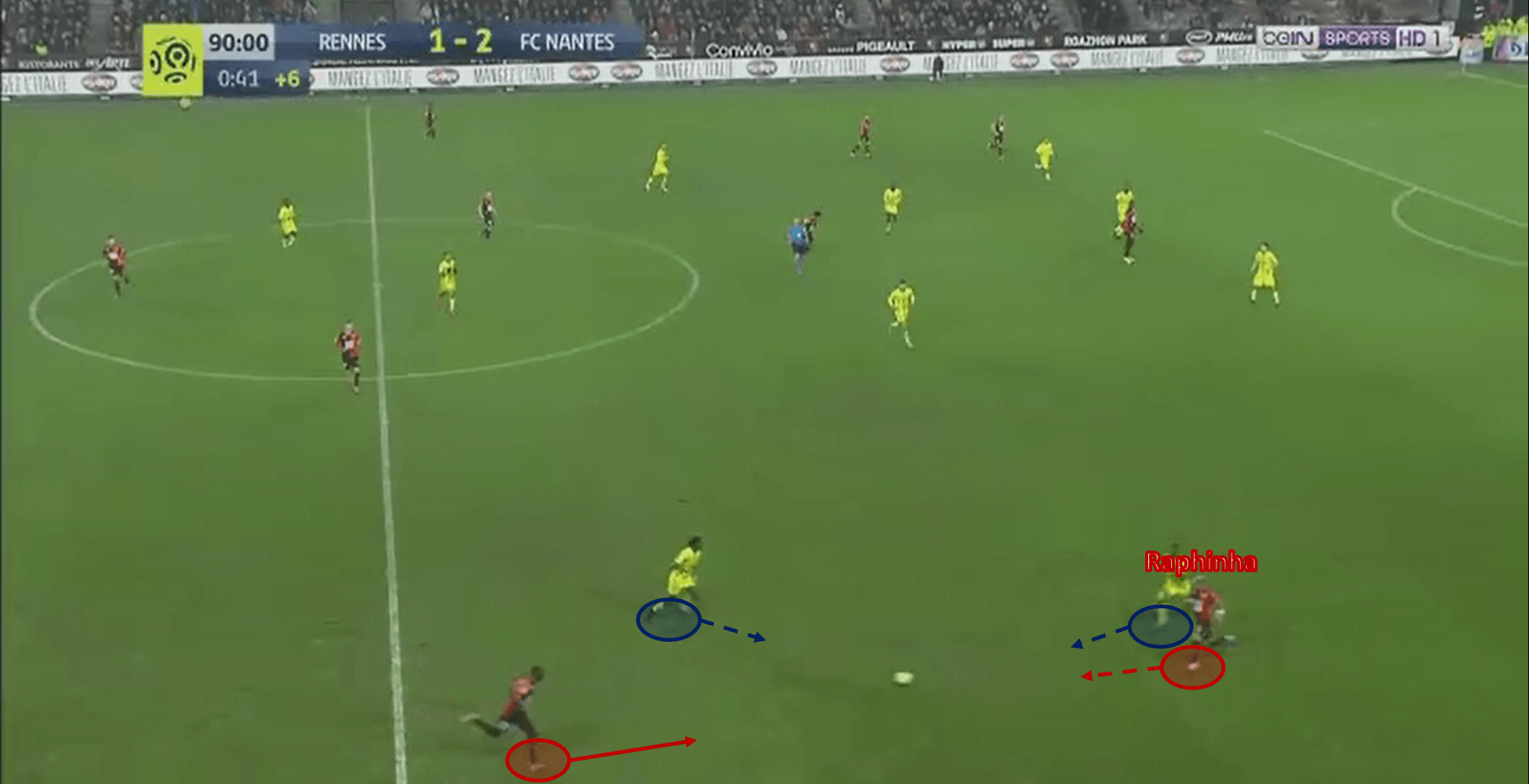
In the above analysis, we see Traoré passing the ball forwards into the path of Raphinha, who is coming deeper to collect the ball as we see him do regularly.
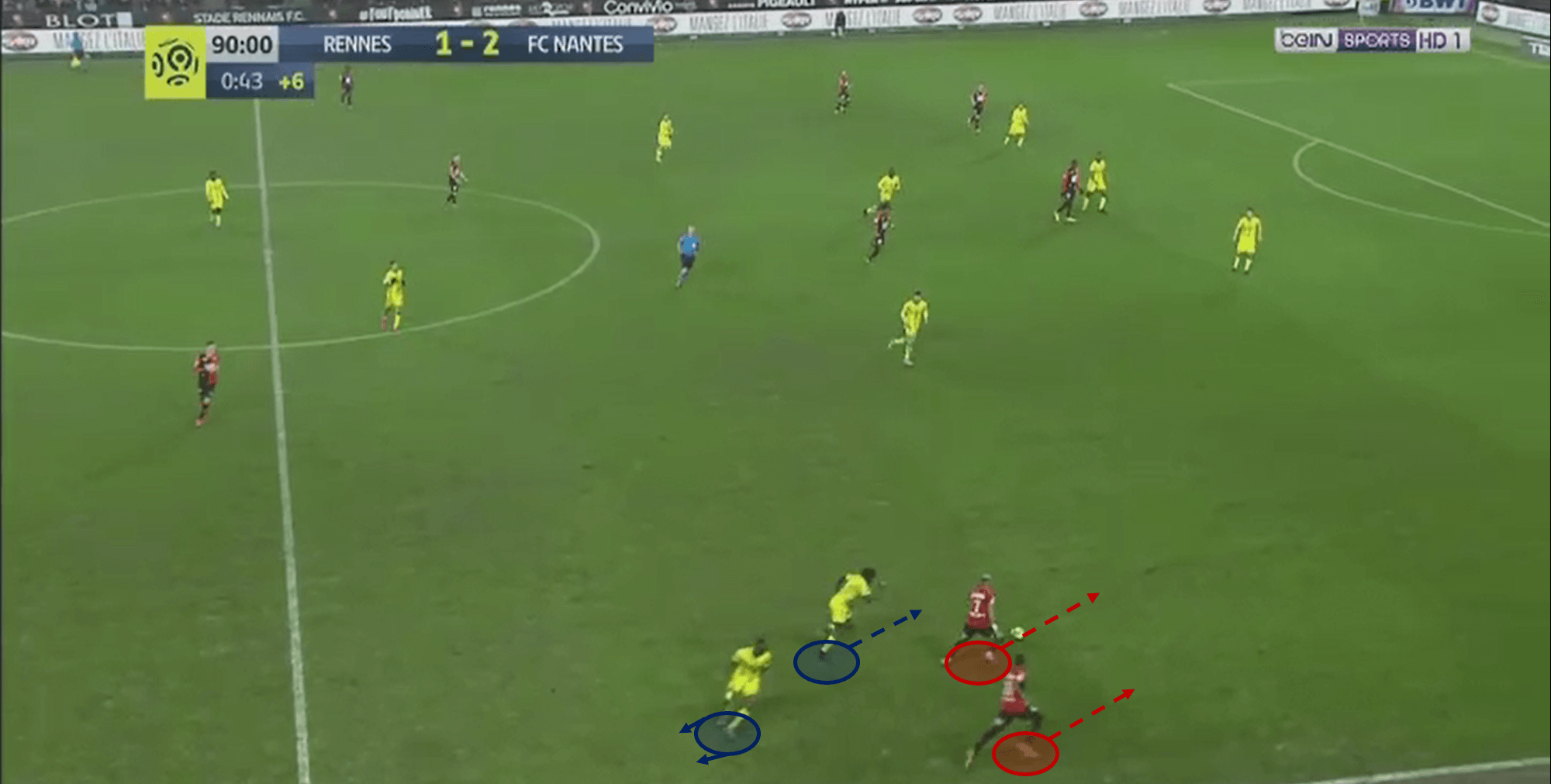
Raphinha manages to fake both defenders and create a lot of green yards to run into and progress the ball into the final third.
At Rennes, these instances are not an anomaly because this is a common theme within Stephan’s tactical concepts. He likes his wide men to drag defenders towards their location, take the ball past them, then drive into the open space they created. At just 5’6”, Doku can use his low centre of gravity and quick feet to glide past defenders, meaning he should fit seamlessly into Stephan’s tactics in this regard.
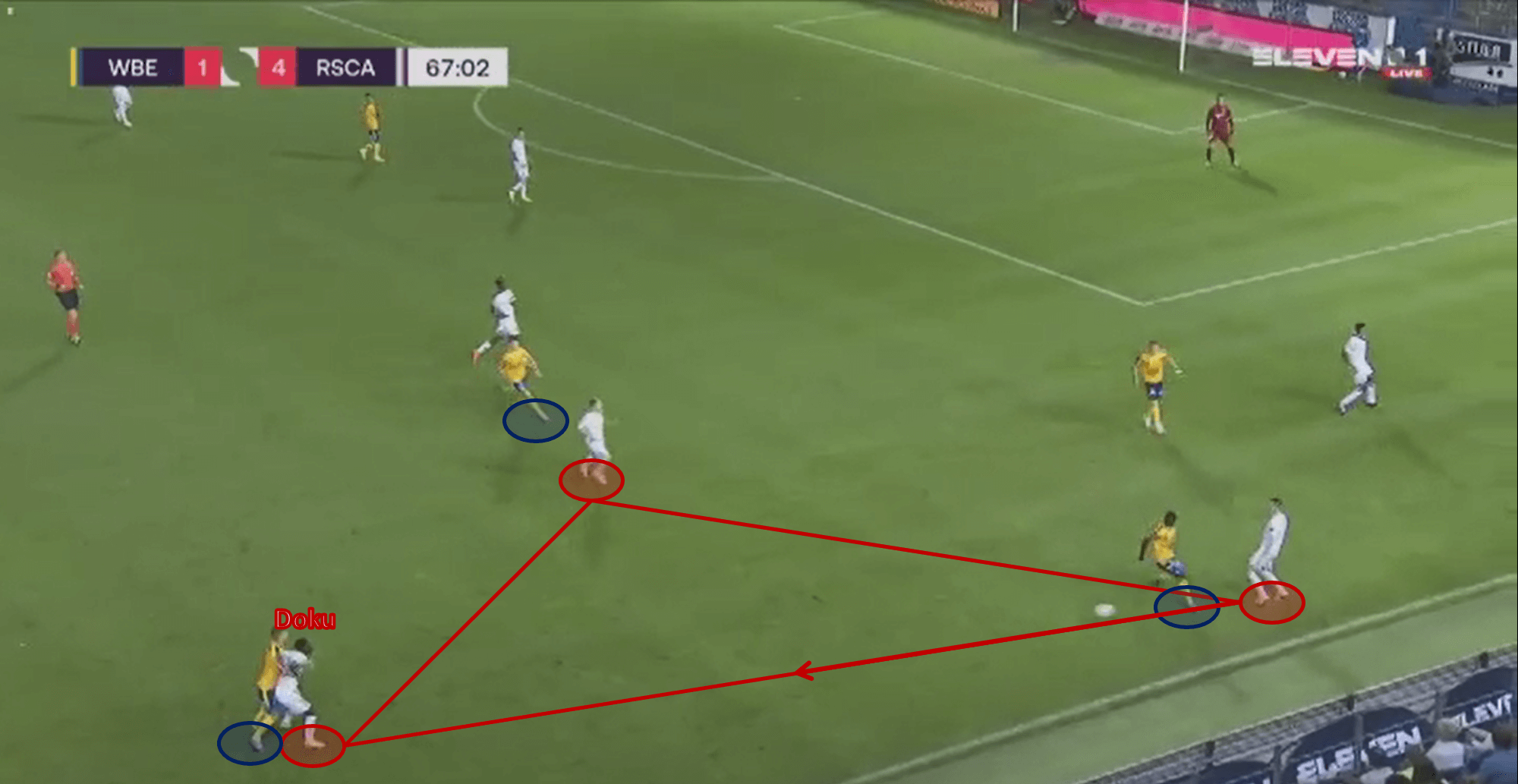
Inside his half, Doku is utilising his body well to jostle with his opponent, with a teammate in the right position to make the run forwards to facilitate in the build-up.
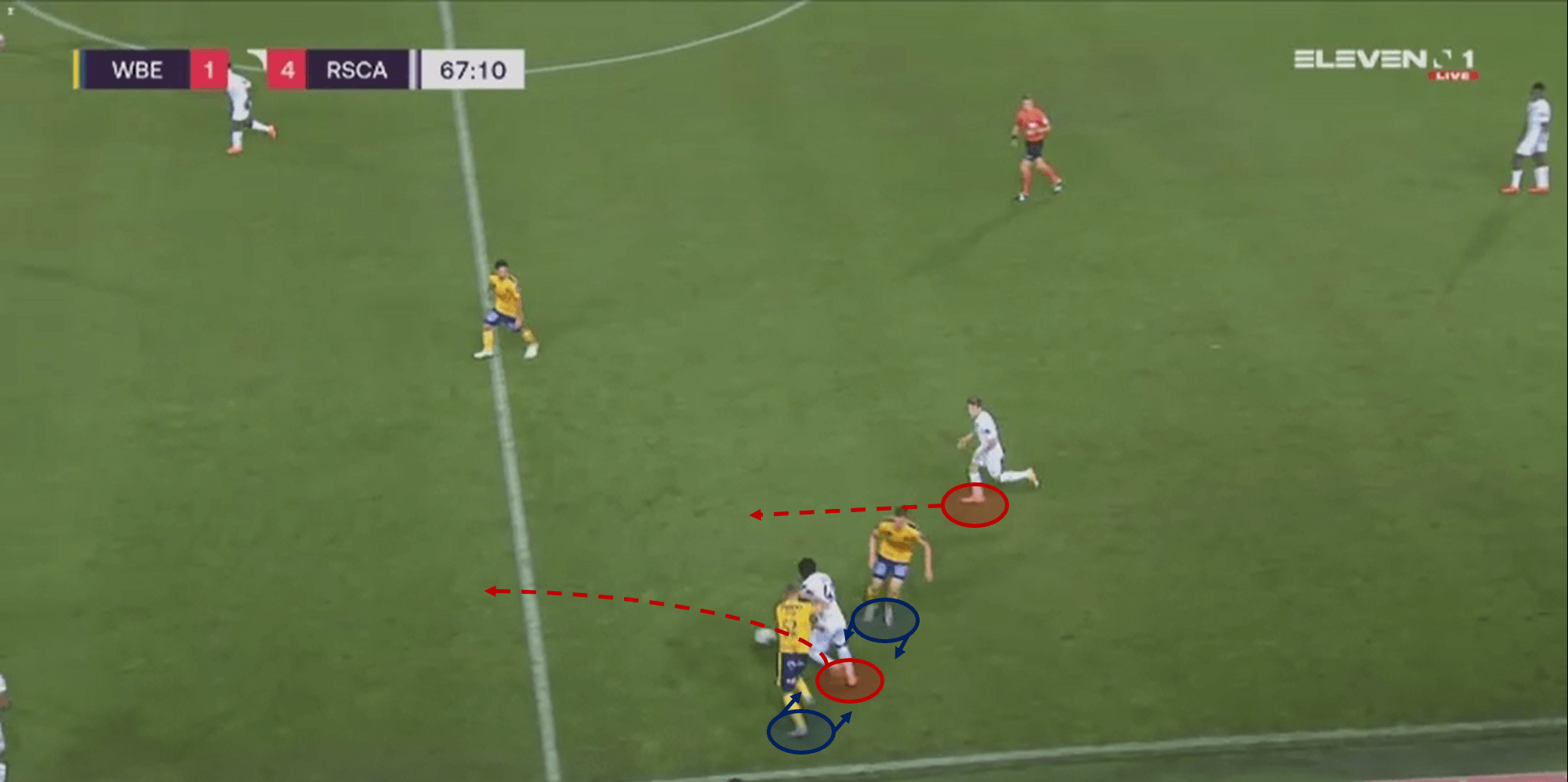
Facing forwards, Doku is agile enough to take it past two opposing defenders and drive into open space, progressing the ball into the final third.
Promising creative fundamentals
Another strong asset in Doku’s skill set in his presence in and around the box. Based on this season’s performances, Doku has been stronger in his goal and assists output than Raphinha. As mentioned earlier, based on early-season form it looks as if Doku had already outgrown the Belgian league, a magnanimous statement to make for such a young player.
In wide areas, stretching opposition’s defences, Doku is good at creating space for teammates in the box and sending in low, driven, and effective deliveries into the penalty area for a teammate to latch onto. He can also provide crosses of height to aim for a fellow attacker’s head, but this is certainly not his preferred method of chance creation.
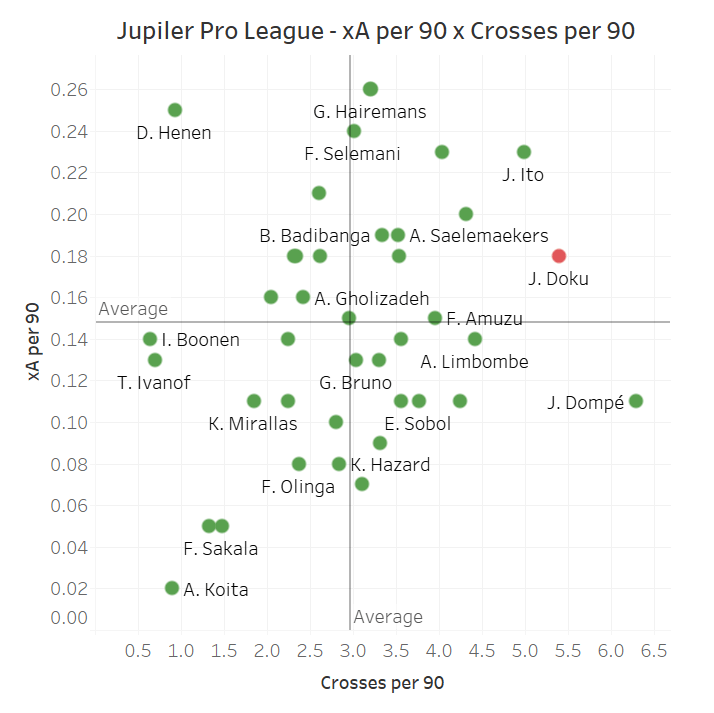
Scatter plot of Jupiler Pro League wingers’ xA per 90 compared crosses per 90 from the 2019/20 campaign.
Compared to other wingers of all ages in the Jupiler Pro League, Doku ranks highly in both regards. Only Jean-Luc Dompé of Zulte Waregem outperforms his 5.4 crosses per 90 which have aided him in producing a relatively high 0.18 xA per 90 in the league last term. By watching the young winger, it is clear to see that there are some fantastic foundations to build upon in terms of creativity, and his statistics back up this statement to a large extent.
Currently, however, Doku is not as much of a creative threat as Raphinha has been for Rennes, but as we have highlighted numerous times, Doku is incredibly young, and his ceiling is very high. While Raphinha, in a sense, is quite limited in his attacking endeavours (his technique can be questioned on occasion), Doku naturally has a skill set which allows him to become a much more proficient winger than the Brazilian.
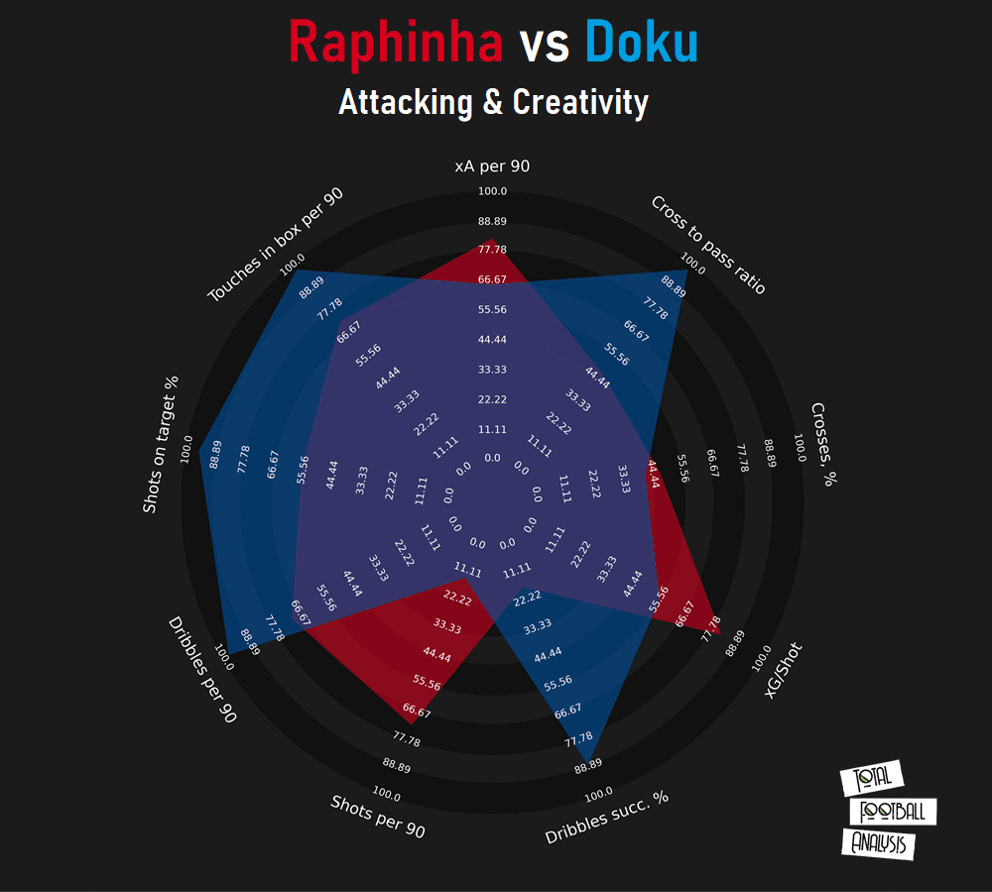
Comparison radar using percentile ranks of Raphinha and Doku from the 2019/20 season of Ligue 1 and Jupiler Pro League, respectively.
Using percentile rankings, in the above radars, we can see the statistical differences between the two players. Some of these disparities are due to the team’s playing styles, for example, Doku has a higher cross to pass ratio than Raphinha, due to Anderlecht’s preference for chance creation is to target players centrally with wide deliveries. Based on their statistical profiles, we can understand that Raphinha is the more well-rounded attacking threat, with higher shots per 90 and xA per 90 to boot, but the 18-year-old is more agile and mobile. Doku has laid down the foundations to become an excellent creative player, now he just needs to add other elements to his already well-established repertoire.
Doku would be expected to enter the half-space more regularly at Rennes, where he can draw defenders one side, and burst into a wide channel with the space he created or looking to play the through pass towards one of Rennes’ forwards. If this is to be the case, it would be more suitable for the 18-year-old to play as a left-winger, where he can cut inside with his preferred right foot and play finessed through balls which would angle more favourably into open space than it would on the other flank.
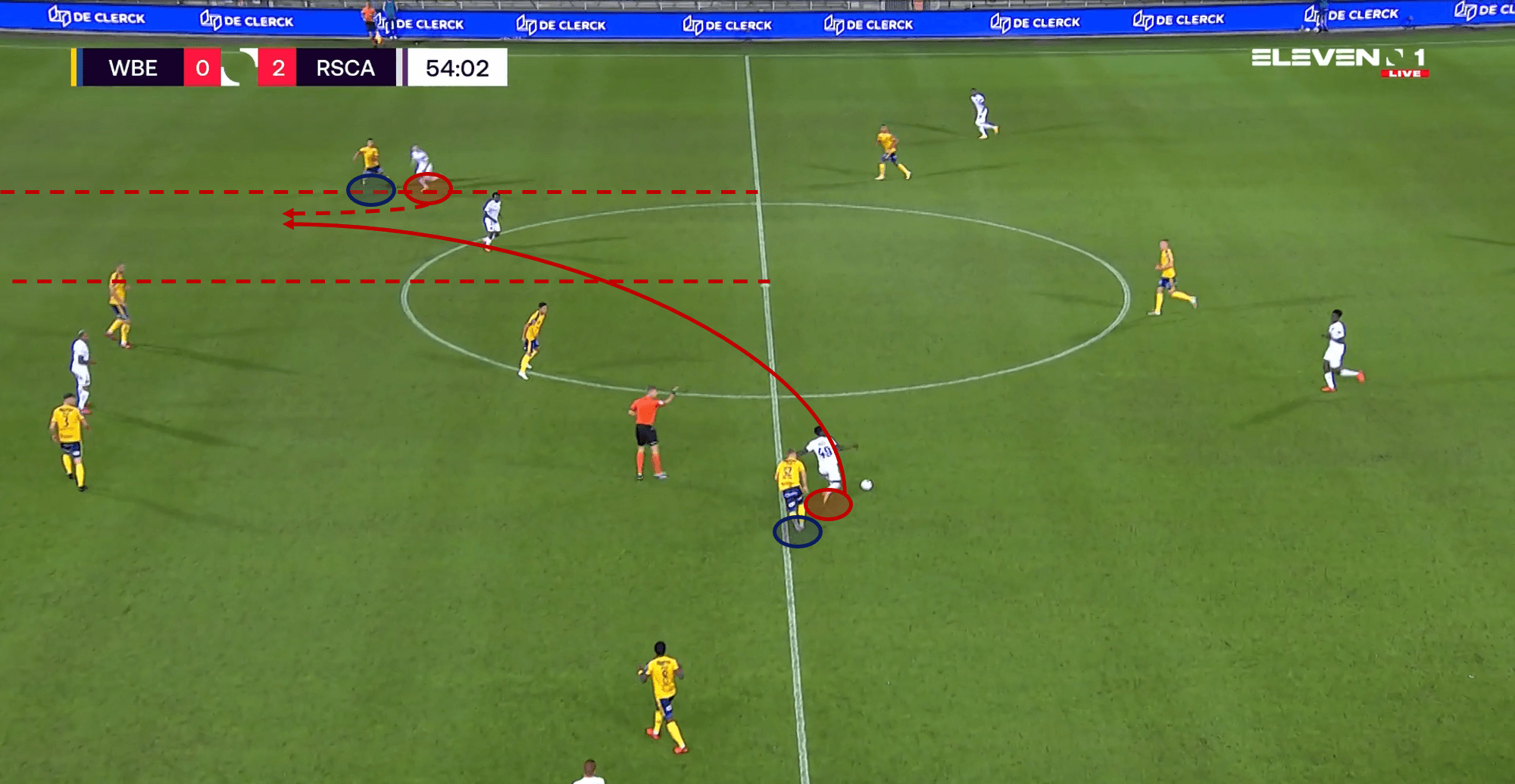
Here, we can see Doku on the ball in a central zone. His superb vision has allowed him to locate an Anderlecht runner, who he finds with precision with a through ball thanks to the curve he places on the pass.
A typical scenario for Doku saw him out in a wide position high up the pitch with the ball at his feet. From here, the opposition needs to have at least two men marking his movements, which drags at least one defender out of position. Last season, the 18-year-old often used his ingenuity to create something out of nothing with an incredibly smart pass. While he would often rush his deliveries into the box, these moments of genius suggest a brighter future for the prodigal talent.
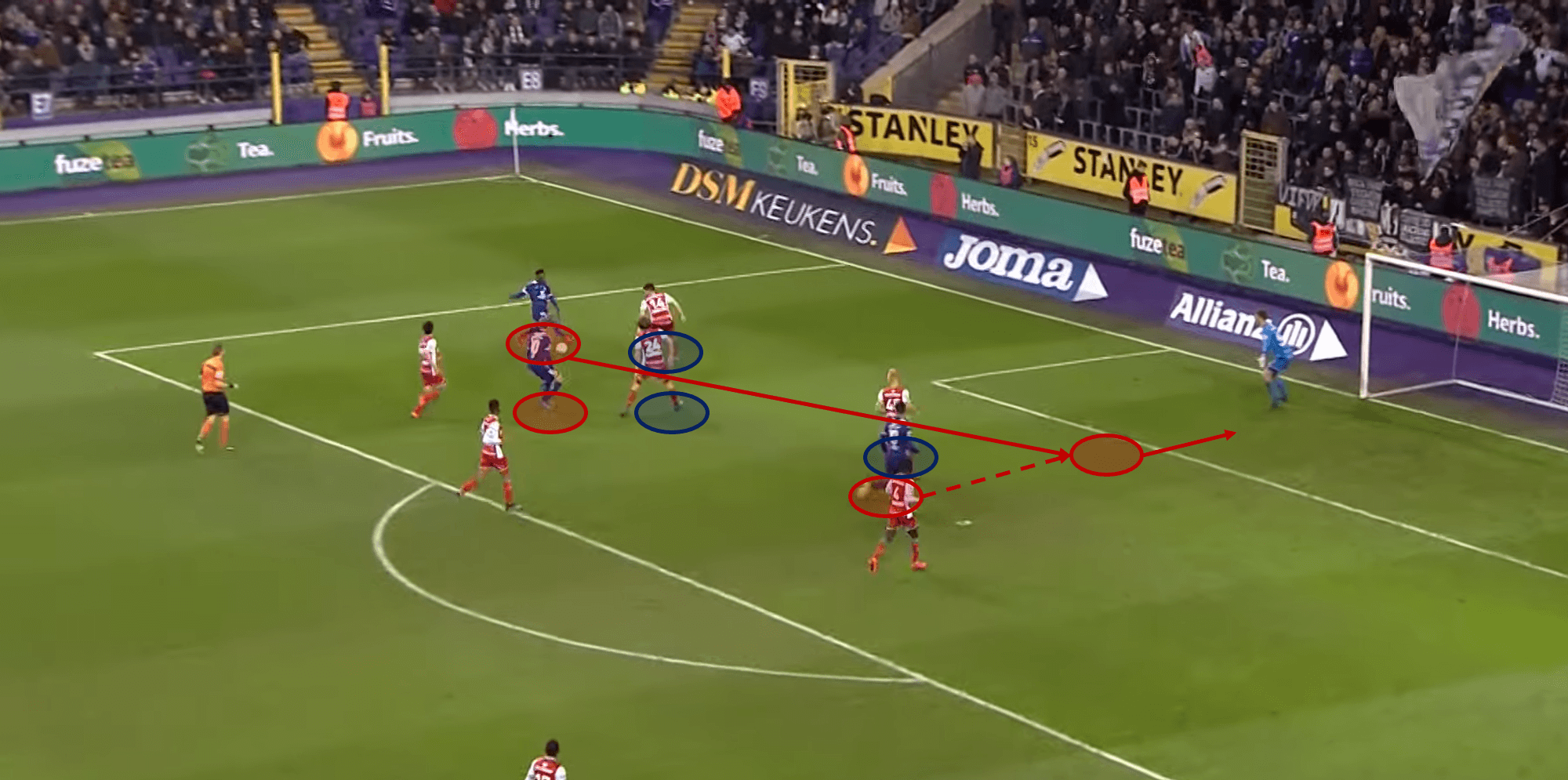
Here, we can see what looks to be a crowded penalty area with little room to manoeuvre. Doku disguises a smart pass as a feint, leaving the opposition defence flat-footed, and as such, he can find his target ably.
Weakness in aerial duels and link-up play
Although Doku is a supremely talented player, he is not without his flaws. Currently, he provides much more value to his side than he takes away from it, but there are certainly areas to improve upon. Naturally, at 5’6”, Doku’s aerial presence is non-existent, even against smaller full-backs where he may stand a better chance than he would in a more central role.
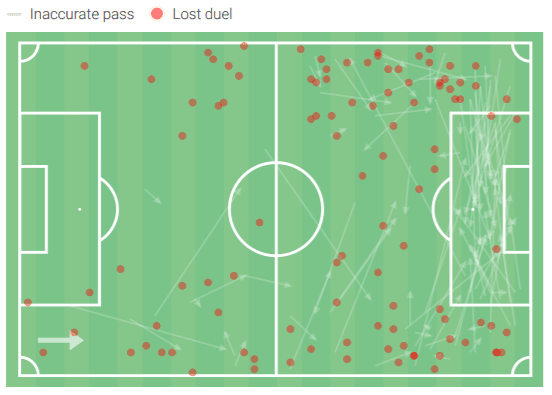
Doku losses in the Jupiler Pro League in the last year.
Thankfully, the majority of these losses are higher up the pitch and are less fatal than if he were to lose the ball in his half. These inaccurate passes are part and parcel of a young creative forward. He is an ambitious passer who is constantly looking to play the ball forward while running with the ball at pace, and as such can rush his placements.
Doku could also improve in his link-up play, although a lot of his drawbacks in this regard are as a result of his small frame. He does really well in his off-the-ball movements, often utilising his pace to good effect on the counter-attack to create chances of really high value. It causes trouble for the opposition and results in Doku being a dual-threat on-the-ball and off it simultaneously. However, whenever he drops deeper to collect the ball, he is often followed and hassled by an opposing player, which regularly puts the young Belgian off balance and forces him into an error.
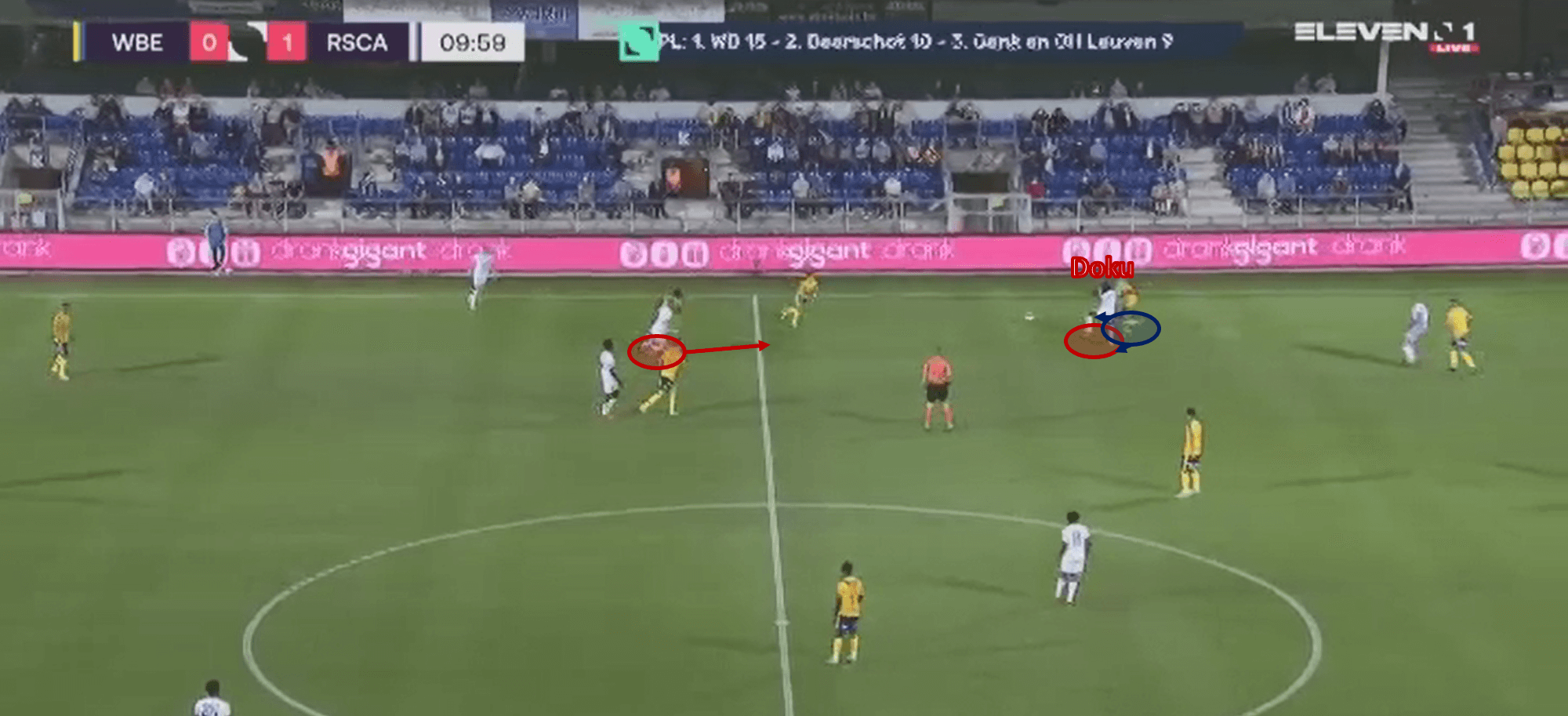
Here, we see Doku collect a pass from his teammate. He receives pressure from the opponent, which puts him off balance, and in turn, he loses possession.
Forecast for the future
At just 18-years-old, Doku is amongst one of the brightest young players in Europe’s top five leagues. At that age, not many can claim to have made a handful of appearances for their highly competitive national senior squad and performing well in those games.
He does not look out of place in senior football, and an adaptation period should be allowed for Doku in France, but once he finds his feet, it is not unrealistic to imagine Liverpool (or any other top European club) circling for his signature once again.

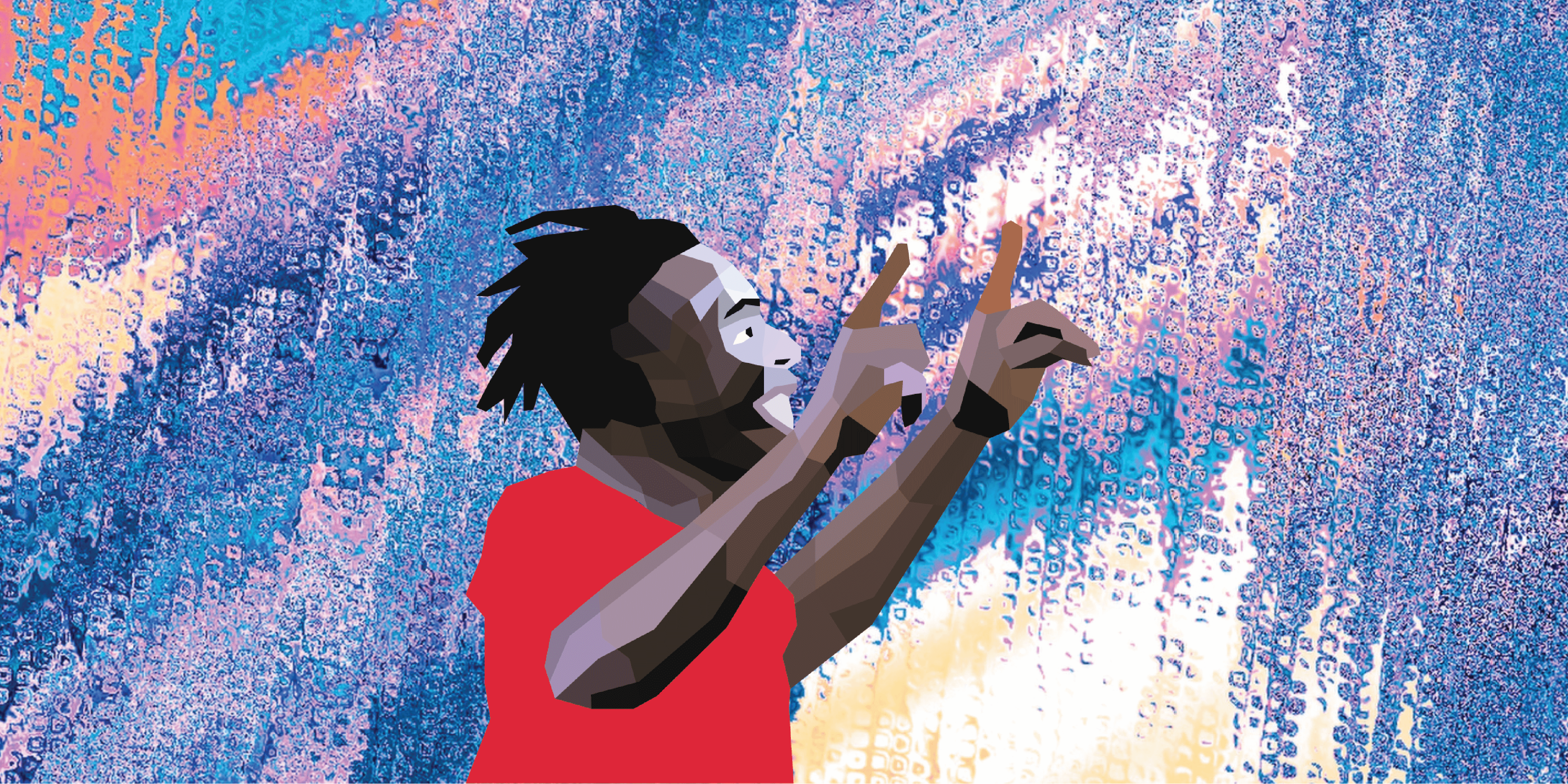



Comments